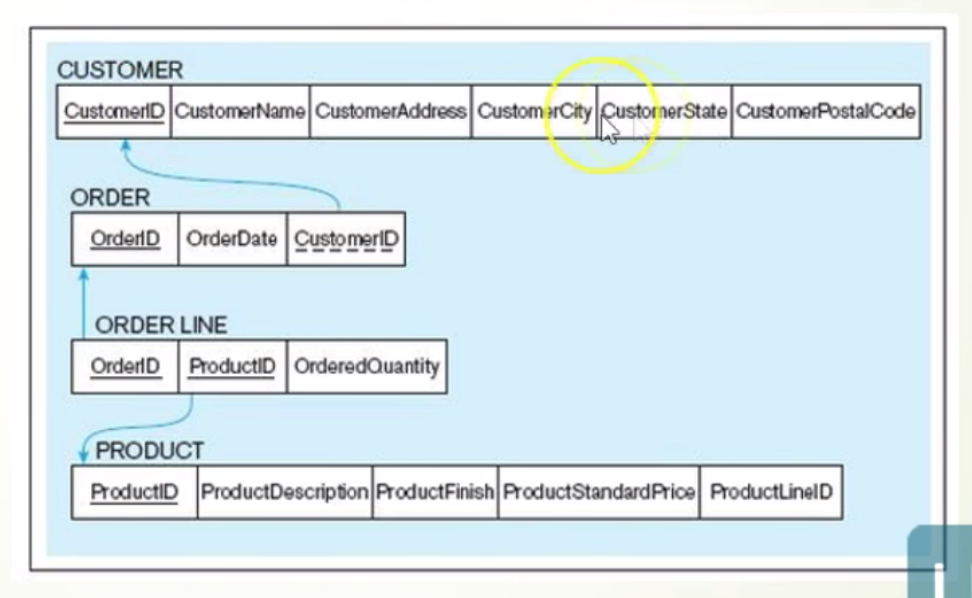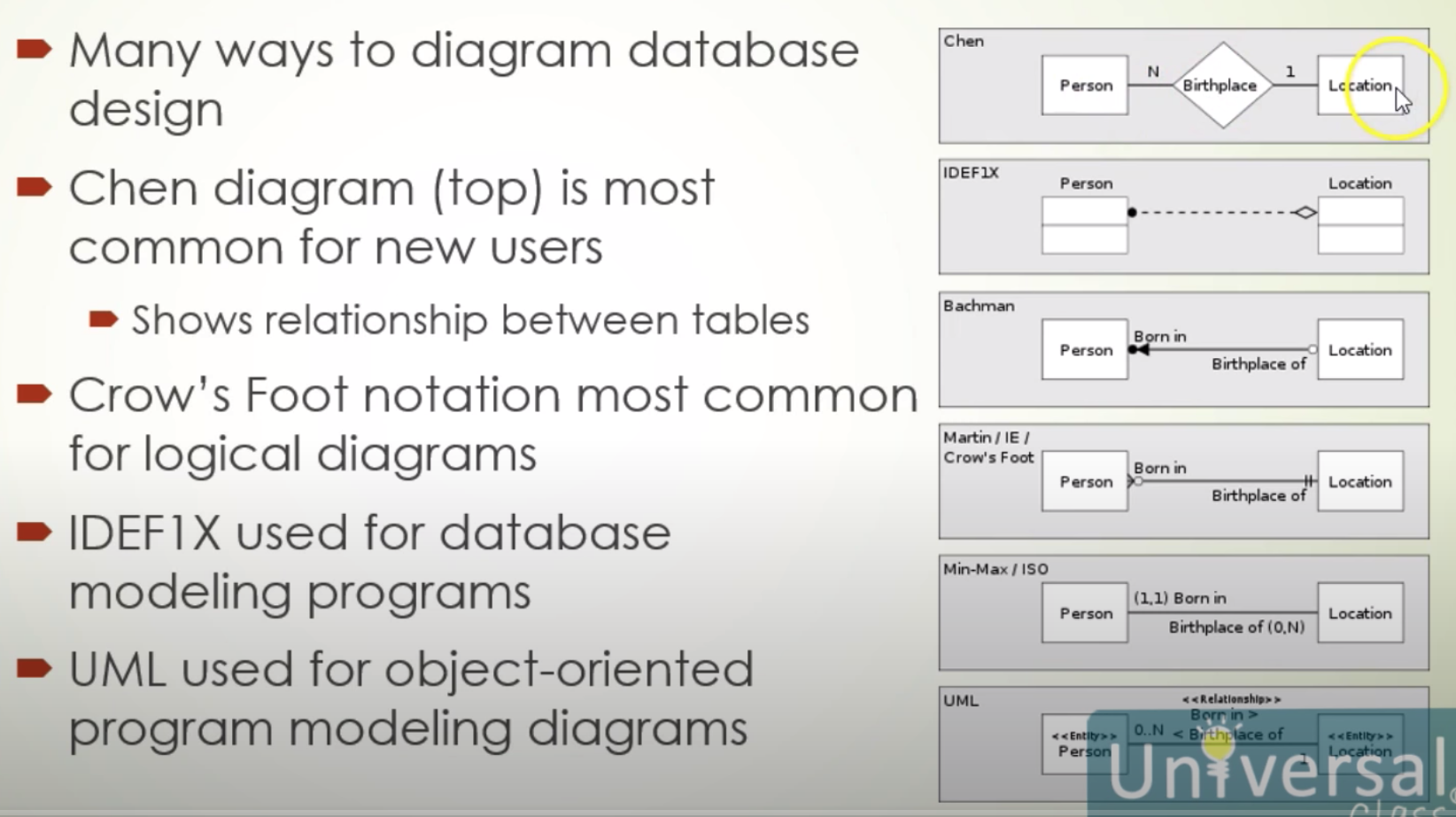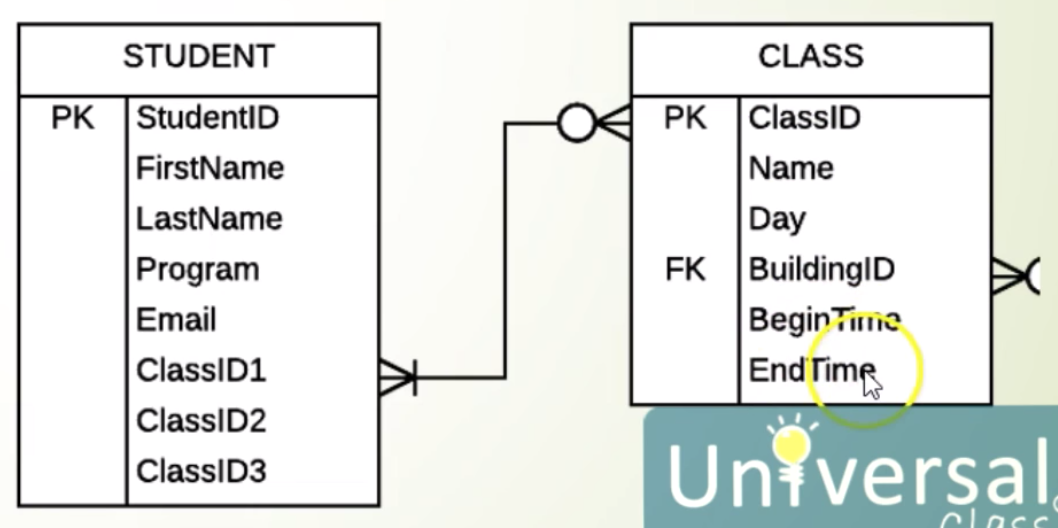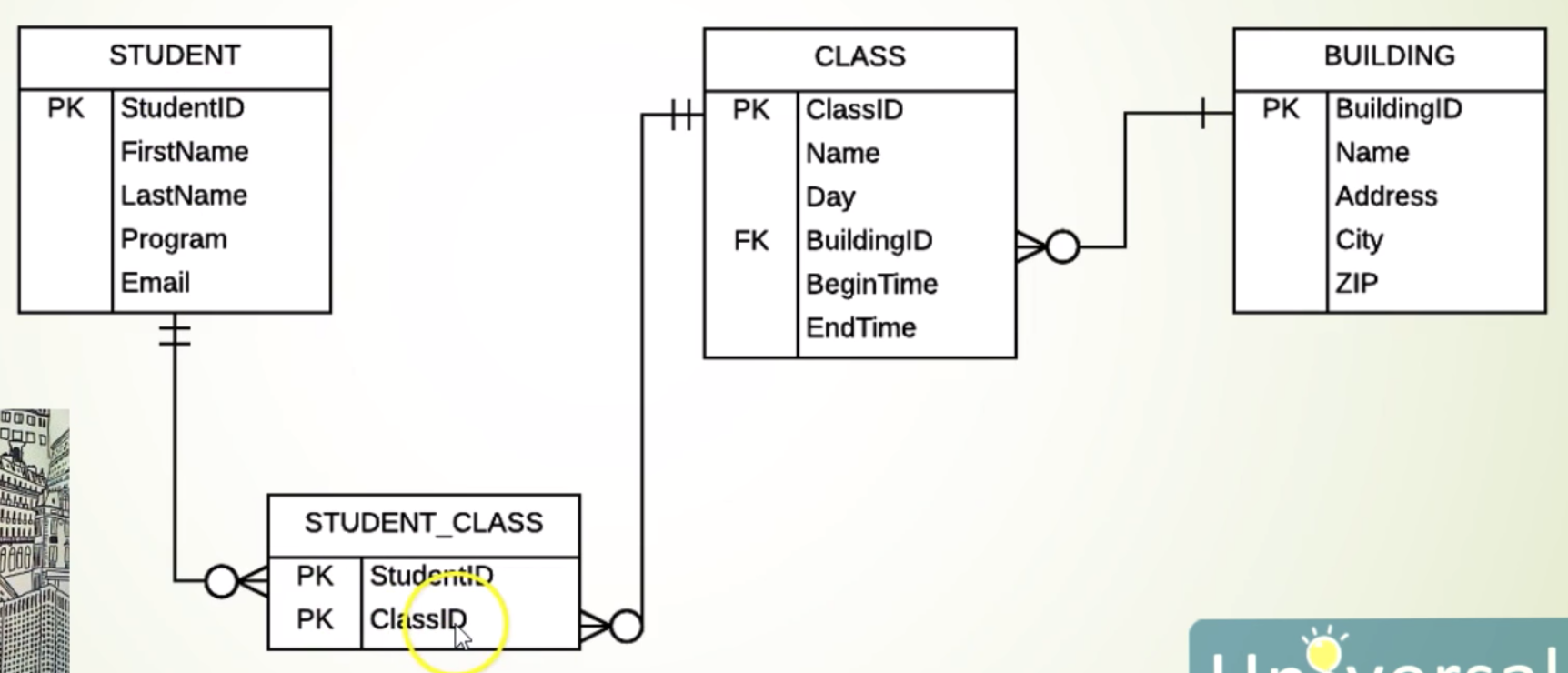MySQL Universalclass Lesson3
https://www.youtube.com/watch?v=5z4IUrCAv4A&t=1s
1 database design
logical design
- general layout
physical design
- which DBMS to use
- constraints of DBMS, security features
2 keywords
schema
- everything making up a database
- tables, views, roles, permissions, indexes, etc
entity = tables
- attribute = column
- tuple/entry/record = row
keys
- primary key = attribute that uniquely identifies a record
- candidate key = attribute that could be selected as a primary key
- composite key = 2 or more attributes making up a primary key
- foreign key = attribute providing relationship (links) one table to another table
- alternate/ secondary key = candidate key not chosen to be primary key
3 referential integrity

- underlined = primary key
- dotted underline = foreign key
- referential integrity = all foreign keys must have corresponding attribute in related table
- shown in ER diagrams with linking arrows
- “whenever I reference something in table2, it better exist in table2”
4 db diagrams

- IDEF1X and Crow’s Foot will be used here
5 ERD
- MS visio (expensive)
- Dia (free) http://dia-installer.de/
- Lucidchart (website, education edition) https://www.lucidchart.com
6 notations
standard (SN)
- entity (table) name listed in capital letters
- attributes (colnames) listed in parenthesis
- primary key underlined
- foreign key dotted underlined
- con: does not have arrows like ERDs
db design language (DBDL)
- alternate to SN
- primary key (PK), secondary key (SK), alternate key (AK), foreign key (FK), listed underneath entity listing
e.g.
STUDENT (student_id, firstname, lastname, program, email)
PK student_id
AK email
CLASS (class_id, name, day, building_id, begintime, endtime)
PK class_id
FK building_id -> BUILDING # building_id is a foreign key
STUDENT_CLASS (student_id, class_id)
PK student_id, class_id
BUILDING (building_id, name, address, city, zip)
PK building_id
7 cardinality
- how tables are related
- how many attributes in one table can be linked to attributes to another table
- 1:1, 1:N, N:N
- try to avoid N:N relationship
crow’s foot notation showing cardinality
0 or 1 -----------0-1-|
exactly 1 -----------1-1-|
0 or many -----------0-<-|
at least 1 or many -----------1-<-|
8 normalization
- progressively modify db table
- reduce redundancy and problems
- prevent update anomalies
- after db made, user can’t insert certain records
- more normalized =
- less problems
- more tables with less attributes
- more processing power needed
- tables more refined
normal form
- 3NF is what we want eventually (least repetitive)
- normalization is progressive, so need 1NF to do 2NF
1st normal form (1NF)
- all records have same number of attributes
- no repeating values
- e.g. PET_OWNER (ID, Name, Pet1, Pet2, Pet3, Pet4, Pet5)
- this creates a artificial limit - cannot have > 5 pets
- wastes space - having < 5 pets, rest will be NULL
- (drawbacks of 1NF)
2nd normal form (2NF)
- primary key defined
- can be composite (2+ columns)
- primary key determines all other attributes

3rd normal form (3NF)
- all non-key attributes depend on primary key,
- and NOT on other non-key attributes
- e.g. table in 2NF but NOT in 3NF

- “manager_name” and “manager_title” does NOT depend on primary key (ID),
- instead depend on non-key attribute “manager_id”
making it 3NF
- split EMPLOYEE table into 3 tables
EMPLOYEE (employee_id, name, address)
PK employee_id
MANAGER (manager_id, name, title)
PK manager_id
EMPLOYEE_MANAGER (employee_id, manager_id) <-- linking table, need a composite key
PK employee_id, manager_id
FK employee_id -> EMPLOYEE
FK manager_id -> MANAGER
example of 1NF vs 2NF vs 3NF
- school keeping track of students enrolled, classes offered
1NF design
-
in STUDENT table: each student is stored in 1 row
-
in CLASS table: each class is stored in 1 row

-
each student limited to 3 classes
-
question = how to correctly relate STUDENT to CLASS?
-
solution = break up STUDENT
3NF design

- STUDENT table strictly only have info about student
- CLASS table strictly only have info about classes
- make a third table STUDENT_CLASS to relate STUDENT to CLASS
- e.g. STUDENT_CLASS table
- student_id = 20 —> STUDENT table to look up student name
- class_id = 3001 —> CLASS table to get class name
- can now have students taking any number of classes
- (multiple class_id entries for same student_id entry in STUDENT_CLASS table)
- and students can take no class
- (won’t be in STUDENT_CLASS table)
cardinality
STUDENT-|-|----0-< STUDENT_CLASS >-0------|-|-CLASS
1:N relationship btw STUDENT and STUDENT_CLASS
1:N relationship btw CLASS and STUDENT_CLASS
in 1NF previous, had N:N (many students to many classes) cardinality, not good design
in 3NF, now have 1 student to many classes, better design
4th normal form (4NF)
- any record should not have > 1 related attribute
- theoretical best, but causes too many lookups and slow response time
- have to de-normalize into 3NF
- e.g. of 4NF: EMPLOYEE table
EMPLOYEE_NAME (emp_id, name)
EMPLOYEE_ADDRESS (emp_id, address)
EMPLOYEE_TELEPHONE (emp_id, telephone)
EMPLOYEE_SALARY (emp_id, salary)
- to extract a employee’s name, address, telephone, salary into a single output
- will require 4 different lookups